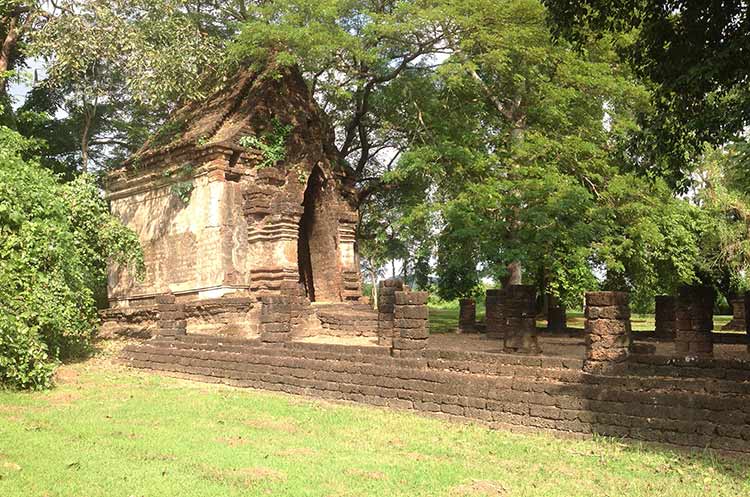
North and South Zone
The areas North and South of the old walled town contain several dozens of ancient monuments, many of them small, comprising of a principal chedi and a viharn. Spread out across a few sites near the Yom river North West of the town are hundreds of kilns where the famous Sangkhalok ceramic wares were produced.
South zone
The South zone contains about a dozen of ancient monuments, including a few hilltop temples.
Wat Khao Yai Bon & Wat Khao Yai Lang
These are two temples built on a forested hill named Khao Yai, South West of the ancient walled town. The Wat Khao Yai Bon comprises of a large Ceylonese style chedi, a viharn and a mondop. Ancient water tanks at the bottom of the hill might indicate that monks lived or meditated here.
The main attraction of the nearby Wat Khao Yai Lang is its large Ceylonese bell shaped chedi.
Wat Yai Ta
The Wat Yai Ta is located near the Saphan Chan gate in the South wall. The temple comprises of a principal chedi, a very large and high mandapa, a viharn in front of it and the remains of several subordinate chedis and small arched shrines.
Wat Phrom Si Na
The temple comprises of a viharn of which little remains and a mandapa with indented corners and now empty niches that once enshrined images of the Buddha. The Wat Phrom Si Na is located South of the town wall near an earthen dike that held water used to irrigate the land during the dry season.
Wat Phaya Dam
The Wat Phaya Dam near the South East corner of the ancient town is enclosed by a wall of laterite blocks. It comprises of a very well preserved mandapa with an arched entrance, another mandapa that enshrined a standing image of the Buddha, a viharn and several dozen subsidiary chedis.
Wat Sa Pathum
The Wat Sa Pathum is found South of the ancient town wall near the Wat Phaya Dam; a laterite walkway connects the two temples. It comprises of a well preserved laterite mandapa with a pointed roof, the ruins of a viharn in front of it and a chedi.
North zone
The zone North of the old walled town contains a few temples and several sites where hundreds of kilns have been excavated.
Wat Kudi Rai
The Wat Kudi Rai is located near the Tao Mo gate in the North West corner of the town wall, just outside the ancient town of Si Satchanalai. The temple comprises of a viharn with a mandapa attached to it, an ubosot with another mandapa attached to it, and a number of small subordinate chedis. Both well preserved laterite mandapas enshrined images of the Buddha. Merely the elevated base and the lower part of columns that supported the roof remains of both the viharn and ubosot.
Sangkhalok ceramic wares kilns
In the villages of Ban Ko Noi and Ban Pa Yang, North West of the ancient town of Si Satchanalai, several hundreds of kilns have been excavated where ceramic wares were produced during the Sukhothai era. The earliest underground kilns started production in the 11th century. Several centuries later large above ground kilns produced glazed ceramics, the best known being the famous Sangkhalok wares, named after Sawankhalok, the name Si Satchanalai was known under during the Ayutthaya era. The ceramic wares were exported to far away places as Japan and the Philippines.
Tao Thu Rieng Ban Ko Noi kilns
More than 200 kilns have been found in the village of Ban Ko Noi. Several sites have been developed into museums. The oldest underground kilns were dug out in the banks of the Yom river. The above ground kilns made of brick produced glazed ceramics during the 14th and 15th centuries. Also in Ban Ko Noi village is the Celadon Kiln Study and Conservation Center, a museum where visitors can view excavated kilns and examples of ancient ceramic wares.
Tao Thu Rieng Ban Pa Yang kilns
Over 20 kilns have been found in Ban Pa Yang village. Apart from pottery, these kilns produced figurines of animals, demons, humans and mythological animals like Makaras.